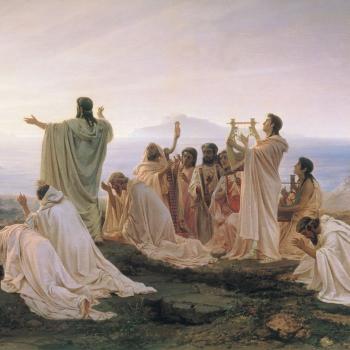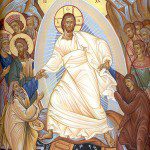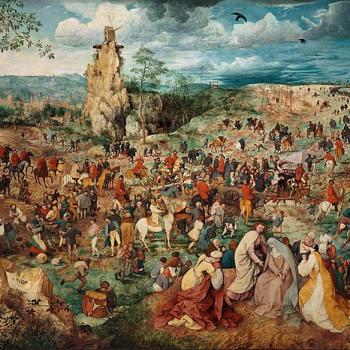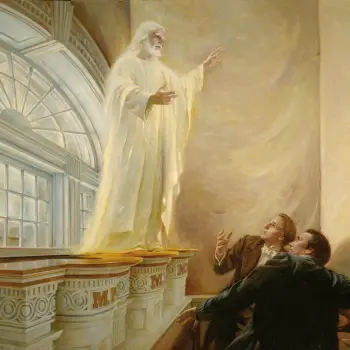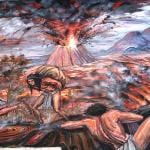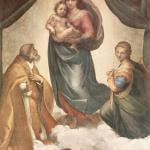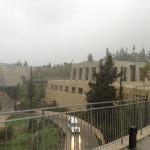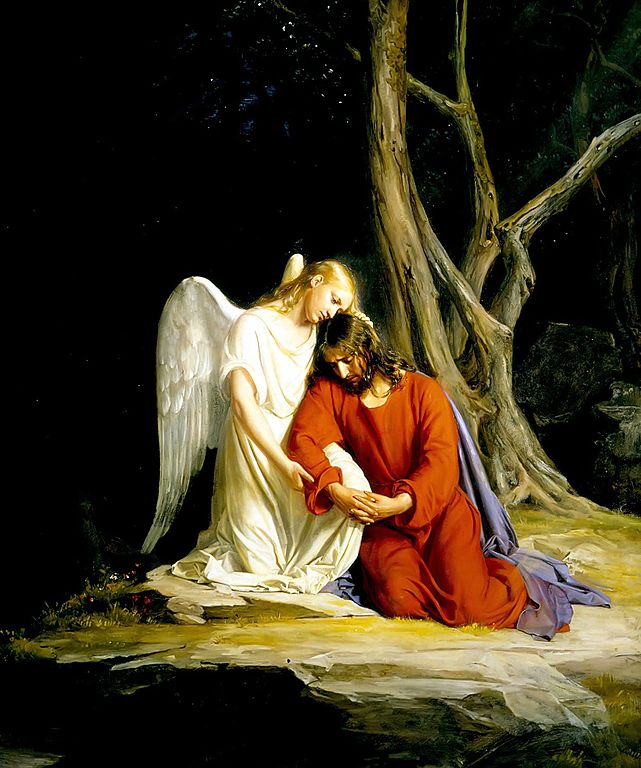
The item below, from Bob and Gloria Rees, was passed on to me yesterday and, with Bob’s kind permission, I’m sharing it here. Brother Rees is a retired member of the faculty at UCLA, as well as a former editor of Dialogue and the co-founder and vice president of the wonderful Bountiful Children’s Foundation (formerly the Liahona Children’s Foundation), whose website, for some reason, I cannot currently access.
I commend the following note to your attention. Thanks to the alertness of a reader, I have corrected some erroneous dates that existed in the original:
This coming week, Latter-day Saints have a rare opportunity to celebrate the holiest week of the year, first, preparing ourselves by listening to general conference and then focusing on the events of this sacred season throughout the week, culminating on Easter Sunday. Undoubtedly, some of the words we will hear from apostles and prophets on this 200th anniversary of the First Vision will help us prepare our hearts and homes for what one person has called, “the most concentrated, symbol-laden, primitive, critical, foundational, animating . . . time in the Christian calendar. . . . [During Easter week] We stand before the emotional well-spring of Christian . . . experience.”
Does Holy Week play a role in the Restoration? We believe it does in a significant way. Although we don’t know the precise date of the First Vision, it is very likely that it took place on Easter Sunday, April 2, 1820. Joseph records the time simply as “early in the spring” (Joseph Smith 2:14). Our reason for speculating that the Father and the Son chose this day to reveal themselves to the young Joseph is that ten years later when the Church was organized, it was between Palm Sunday and Easter Sunday, 1830, and sixteen years later when Christ appeared to Joseph and Oliver in the Kirtland Temple, April 3, 1836, it was Easter Sunday. In fact, that entire week seems to have been a holy week, for on Palm Sunday, March 27th, Joseph dedicated the temple and at the conclusion of his prayer the congregation sang “The Spirit of God Like a Fire is Burning” and then partook of the sacrament. Joseph recorded, “We sealed the proceeding of the day by shouting hosana to God and the Lamb 3 times sealing it each time with Amen, Amen, and Amen.” Although Joseph does not so indicate, this is the very shout given by those who welcomed Jesus into Jerusalem on the first Palm Sunday heralding the beginning of the most memorable week in history.
The following Tuesday and Wednesday of that week in Kirtland witnessed the ceremony of washing of the feet, which was also first performed during Christ’s last week. This happened in first among the presiding elders and then among a larger group of three hundred saints and, finally, by the First Presidency washing the feet of the Twelve. On this same Wednesday, according to the Prophet, “the Savior made his appearance to some, while angels ministered unto others, and it was a Pentecost and endowment indeed.” Holy Thursday was another ceremonious day in the temple. Easter Sunday, however, included a series of remarkable spiritual manifestations, including the appearance of Moses, Elias and Elijah. The most glorious vision was of the resurrected Christ, who stood “upon the breast work of the pulpit. . . . under his feet was a paved work of pure gold, in color like amber: his eyes were as a flame of fire; the hair of his head was like the pure snow, his countenance shone above the brightness of the sun, and his voice was as the sound of the rushing of great waters.”
That these remarkable events should occur during Holy Week is, to our mind, highly significant. Throughout the scriptures the Lord uses dramatic events, including the marking of significant days or anniversaries, to teach important principles. We believe that part of the message in the Sacred Grove, in Fayette, and in Kirtland was that these holy days should be remembered and celebrated, especially by those of us who have taken upon ourselves the name of Christ.
Here are some things every family can do to mark this remarkable week (You might consider keeping a personal journal of your thoughts, feelings, and observation throughout this week):
Saturday, April 4: Watch general conference, paying particular attention to the talks that focus on the Savior and the First Vision.
Sunday, April 5: Sing, Hymn No. 69, “All Glory Laud and Honor,” which celebrates Palm Sunday, Christ’s triumphant entry into Jerusalem to begin the last week of his ministry. Watch general conference, again paying attention to the speakers who talk about Christ’s atonement and resurrection and the First Vision.
Monday, April 6: Hold Family Home Evening and sing hymns and read scriptures about Jesus’ coming into Jerusalem (Matthew 21:1–11, Mark 11:1–11, Luke 19:28–44, and John 12:12–19). Show images from Google Images (“Jesus’ entry into Jerusalem”). Share testimonies.
Tuesday, April 7: Read about the organization of the Church on April 6, 1830: https://www.churchofjesuschrist.org/study/ensign/1971/01/april-6-1830-the-day-the-church-was-organized?lang=eng
Wednesday, April 8: Read the story of the remarkable woman who anoints Jesus in preparation for his burial (Luke 7:36-7:50). Discuss how having our sins forgiven increases our love of and devotion to God. Read about other anointings by women in Matthew 26:6-13 and Mark 14:3-9 and talk about what these events teach us.
Thursday, April 9: (Sometimes called “Holy Thursday, “Great Thursday” or “Maundy Thursday” (from the Latin mandatum or “command,” relating to Jesus’ two great commands to love God and others as ourselves. This is the day of the Last Super, Jesus washing the feet of his disciples, and his harrowing experience in the Garden of Gethsemane where he took upon himself the burden of all our sins, suffering so greatly that, as Luke says, “And being in an agony he prayed more earnestly: and his sweat was as it were great drops of blood falling down to the ground” (Luke 22:44). You might consider reading or listening to Chapter 33 from Talmage’s Jesus the Christ about the events of this momentous day (a free recording is available at: https://archive.org/details/JesusTheChrist/JesusTheChrist-Chapter33-TheLastSupperAndTheBetrayal.mp3). See the text at: https://www.churchofjesuschrist.org/study/manual/jesus-the-christ?lang=eng. Share testimonies about what the atonement means to you personally.
Friday April 10. Known as “Good Friday” or “Great Friday,” the day Jesus was crucified.
Read about this from the gospels: (Matthew 27:1-50; Mark 14:53-73 and 15:1-38; Luke 22:39-71 and 23:1-49; John 19:142). Watch Elder Holland’s 2009 conference Address, “None Were With Him”:
https://www.churchofjesuschrist.org/study/general-conference/2009/04/none-were-with-him?lang=eng; see images of the Crucifixion on Google Images and share feelings of this great event and what it inspires you to do.
[And, now and very appropriately for the day, President Russell M. Nelson has invited us all to participate in a Church-wide special fast with a focus on the COVID-19 pandemic. -dcp]
Saturday, April 11: Read the scriptures about Christ’s burial. Read what happens among the Nephites: 3 Nephi 8-10.
Sunday, April 12: Easter Sunday, “He Is Risen!” If you feel comfortable doing so, rise just before dawn and sing hymns celebrating Easter from the hymnbook. Read the gospels about the resurrection. Read 3 Nephi 11. Read and or listen to Talmage’s Chapters 36-37 (from the same sources cited above). Read Elder Monson’s “He is Risen” conference address: https://www.churchofjesuschrist.org/study/general-conference/1981/10/he-is-risen?lang=eng. If you feel comfortable doing so, walk in nature with your family and observe all the new flowers and grasses, the blossoming trees, and share your feelings with one another about the renewal of the world which symbolizes our individual spiritual renewal through Christ and the great gift of a physical resurrection.
Take time to listen to great music, including the Easter section of Handel’s Messiah, Bach’s great Passion According to St. Matthew and Passion According to St. John which are available for free on You-Tube.
Plan on ways you can take the great spiritual gifts from this week to strengthen you during the coming weeks and months as you and your family face the challenges of the coronavirus. Pray for those who are adversely affected by the virus and spread the good news—Christ has risen indeed!
Robert A. Rees, Ph.D.
Visiting Professor & Director of Mormon Studies
Graduate Theological Union
Berkeley, California



